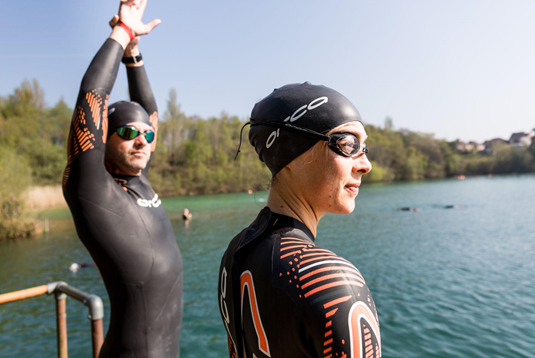Open water swimming can have such vast benefits with very little initial cost, all you need is a wetsuit! However, a supermarket shortie wetsuit will hinder rather than help you, you need a suit from a reputable supplier such as a wetsuit centre to ensure you are ready for that cold natural water.
Once you are suited up, a little know-how and a safety buddy is all you require and you’ll be good to jump in.
So why not dip your toe into another world because what lies beneath can be fascinating!
Tip 1: Practice in a Pool
Pool swimming and OWS are a little different due to the approach you take. This is no walled chlorinated pool, this is nature! You will be tackling currents, winds, unknown depths and a variety of factors so your adaptability is the most important thing!
Technique Tips for the Pool:
● You should have a flattish and wide hand when it enters the water, keep your hands relaxed and your fingers slightly apart.
● A high elbow provides a strong anchor for the catch. Swimming in choppy conditions may mean that you need to use a higher arm recovery. If it’s too low, your hand could enter the water too early or be hit by a wave, causing you to lose balance.
● Kick your legs in a regular steady rhythm, not too fast, as you’ll waste precious energy. The aim is to kick or flutter your legs to keep high in the water and reduce drag.
Tip 2: Control Your Breath
Controlling your breathing is arguably the most important factor when learning open water swimming. Poor breath technique will cause fatigue and increase your stress levels when swimming.
Practice breathing on both sides, so if the waves and wind are choppy on the left say, you can breathe on the right. Exhale underwater so as you turn your head you are ready to breathe in. Turn your head clear of the water before you start to inhale.
Tip 3: Look Where You Are Going
Frequent sighting, keeping on course and swimming in a straight line is advised – it takes you less energy and time to get to the same place if you swim in a straight line.
Pick a fixed object to ‘sight’ in the direction you want to swim, better still if there are two objects one in front of the other that line up in your direction. Then, as long as you keep the two objects in alignment, you are swimming in a straight line.
A good swimming wetsuit can also help keep you tracking straight, as the bouncy in your legs reduces the effect your leg kick may have on your direction.
Tip 4: Never Swim Alone
Even professional triathletes don’t swim alone, it is imperative that you consider your safety by either swimming with a partner or by having a spotter on the shore keeping an eye on you.
You could also swim with a swim buoy. Attached to your body, the buoy can provide extra visibility for those keeping an eye on you as well as a floatation device to help you rest and catch your breath while out in the water.
Image Source: Unsplash















